
Rock n' Roll Racing is a vehicular combat-based racing video game developed by Silicon & Synapse and published by Interplay Productions for the Super Nintendo Entertainment System in 1993 and the Mega Drive/Genesis in 1994. The game prominently features a number of popular heavy metal and rock songs in its soundtrack, hence the game's title. After Silicon & Synapse rebranded into Blizzard Entertainment, a port to the Game Boy Advance was released in 2003. In celebration of the company's 30th anniversary, a new version titled Definitive Edition alongside emulated re-releases of the original game were re-released for Microsoft Windows, Nintendo Switch, PlayStation 4 and Xbox One as part of the Blizzard Arcade Collection in February 2021.

Bigfoot is a monster truck. The original Bigfoot began as a 1974 Ford F-250 pickup that was modified by its owner Bob Chandler beginning in 1975. By 1979, the modifications were so extensive, the truck came to be regarded as the first monster truck. Other trucks with the name "Bigfoot" have been introduced in the years since, and it remains a well-known monster truck moniker in the United States.
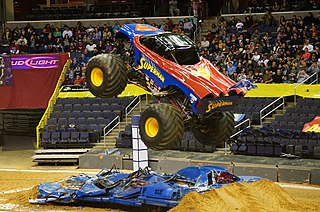
A monster truck is a specialized off-road vehicle with a heavy duty suspension, four-wheel steering, large-displacement V8 engines and oversized tires constructed for competition and entertainment uses. Originally created by modifying stock pickup trucks and sport utility vehicles (SUVs), they have evolved into purpose-built vehicles with tube-frame chassis and fiberglass bodies rather than metal. A competition monster truck is typically 12 feet (3.7 m) tall, and equipped with 66-inch (1.7 m) off-road tires.

Stunt Race FX, known in Japan as Wild Trax, is a racing video game developed by Nintendo and Argonaut Software and published by Nintendo for the Super Nintendo Entertainment System. It is the second game to use the 3D-centric Super FX powered GSU-1.
The Lotus series consists of three racing computer games based around the Lotus brand: Lotus Esprit Turbo Challenge, Lotus Turbo Challenge 2, and Lotus III: The Ultimate Challenge. Published between 1990 and 1992 by Gremlin Graphics, the games gained very favourable reviews upon release. Original Amiga versions of the games were created by Shaun Southern and Andrew Morris of Magnetic Fields, and then ported by other individuals to several other computers and game consoles.
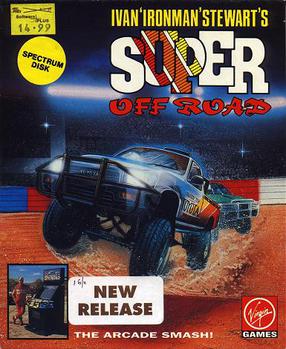
Ivan 'Ironman' Stewart's Super Off Road is an arcade video game released in 1989 by Leland Corporation. The game was designed and managed by John Morgan who was also lead programmer, and endorsed by professional off-road racer Ivan Stewart. Virgin Games produced several home versions in 1990. In 1991, a home console version for the Nintendo Entertainment System was later released by Leland's Tradewest subsidiary, followed by versions for most major home formats including the Master System, Genesis, Super NES, Amiga, and MS-DOS. A port for the Atari Jaguar was announced but never released. Some of the ports removed Ivan Stewart's name from the title due to licensing issues and are known simply as Super Off Road.

The United States Hot Rod Association (USHRA) was an organization that sanctioned various motorsports. These included the Monster Jam monster truck series as well as motocross, quad racing and others. Having passed through multiple owners, the rights to the group are now owned by Feld Entertainment, which continues to operate the Monster Jam series.

Konami Krazy Racers is a 2001 kart-themed racing video game published and developed by Konami for the Game Boy Advance, released as a launch title for the system. Konami Krazy Racers makes use of a variety of characters and concepts from several of Konami's franchises, including Castlevania, Metal Gear, and Gradius. It plays similarly to the Mario Kart series, with eight characters per circuit and offensive/defensive items placed at predetermined points in the tracks. Konami Krazy Racers received mostly positive reviews. It was later released through the Virtual Console for Wii U in 2015.

Grand Prix 2, released in North America as "Grand Prix II", is a racing simulator released by MicroProse in 1996. It is a sequel to Formula One Grand Prix. It was made under an official FIA license that featured the Formula One 1994 season, with all of the circuits, teams, drivers and cars. The cars were painted with liveries reflecting the races that did not allow tobacco and alcohol sponsors.

Monster Truck Madness is a racing video game developed by Terminal Reality and published by Microsoft. It was released in North America on September 9, 1996. The game has twelve monster trucks and tasks the player with beating computer opponents. Checkpoints, multiple hidden shortcuts, and interactable objects commonly appear in the tracks. In the garage, the player modifies the truck to account for terrain surfaces. Online multiplayer is accessed with a modem, a local area network (LAN), or TCP/IP.
USA-1 is a monster truck that competed during the 1980s and 1990s, named after a Chevrolet ad campaign. It competed against Bigfoot in the first televised monster truck race on the American television show That's Incredible! in 1983. The truck was initially painted blue before it was repainted in white.
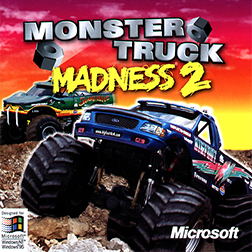
Monster Truck Madness 2 is a monster truck racing video game developed by Terminal Reality and published by Microsoft for the PC in 1998. It is the sequel to Monster Truck Madness for the same platform, and was one of the first racing games to feature an online multiplayer mode. Online play for it was available on the MSN Gaming Zone until early 2006.
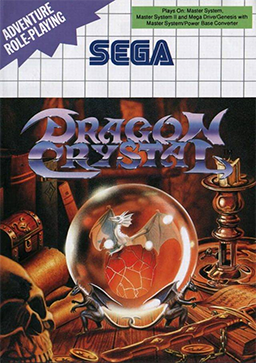
Dragon Crystal (ドラゴンクリスタル) is a 1990 video game developed and published by Sega for their Game Gear and Master System. The game is similar to and shares assets with Fatal Labyrinth, which was also released around that time.

The Duel: Test Drive II is a 1989 racing video game developed by Distinctive Software and published by Accolade for Amiga, Amstrad CPC, Apple IIGS, Commodore 64, MS-DOS, MSX, ZX Spectrum, Atari ST, Sega Genesis and SNES.

Indianapolis 500: The Simulation is a 1989 computer game for MS-DOS. It was hailed as the first step of differentiating racing games from the arcade realm and into racing simulation. It was developed by the Papyrus Design Group, and distributed by Electronic Arts. An Amiga port was released in 1990.
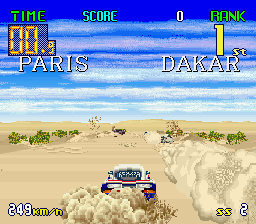
Big Run is a rally racing arcade video game released by Jaleco in 1989. Rendered in 3D, the game is the first to be set in the Paris-Dakar rally raid which the player drives a Porsche 959, resembling that of the 1986 winner. Opponents in the game resemble Peugeot 205 T16s, which went on to win in the 1987 Paris-Dakar rally, with Mitsubishi Pajeros also appearing occasionally.

Last Armageddon is a 1988 post-apocalyptic role-playing video game for the NEC PC-8801, MSX, Sharp X68000, MS-DOS, PC Engine CD-ROM², and Nintendo Family Computer. The game was exclusively in the Japanese language until an English translation patch was created for the Nintendo Famicom.
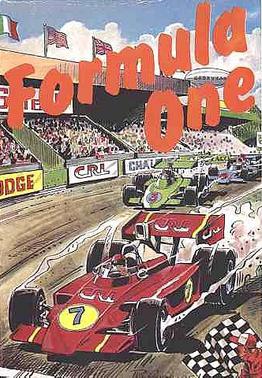
Formula One is a Formula One racing management video game published in 1985 by CRL Group PLC. It was developed by G.B. Munday and B.P. Wheelhouse for the ZX Spectrum, and converted to Amstrad CPC by Richard Taylor.

Road Rash is a 1994 racing and vehicular combat video game originally published by Electronic Arts (EA) for the 3DO Interactive Multiplayer. A version for the Sega CD was developed simultaneously and released in 1995 to act as a "bridge" between the 3DO version and the Sega Genesis title Road Rash 3, and the game was subsequently ported to the PlayStation, Sega Saturn, and Microsoft Windows in 1996. The game is the third installment in the Road Rash series, and is centered around a series of motorcycle races throughout California that the player must win to advance to higher-difficulty races, while engaging in unarmed and armed combat to hinder the other racers.

















